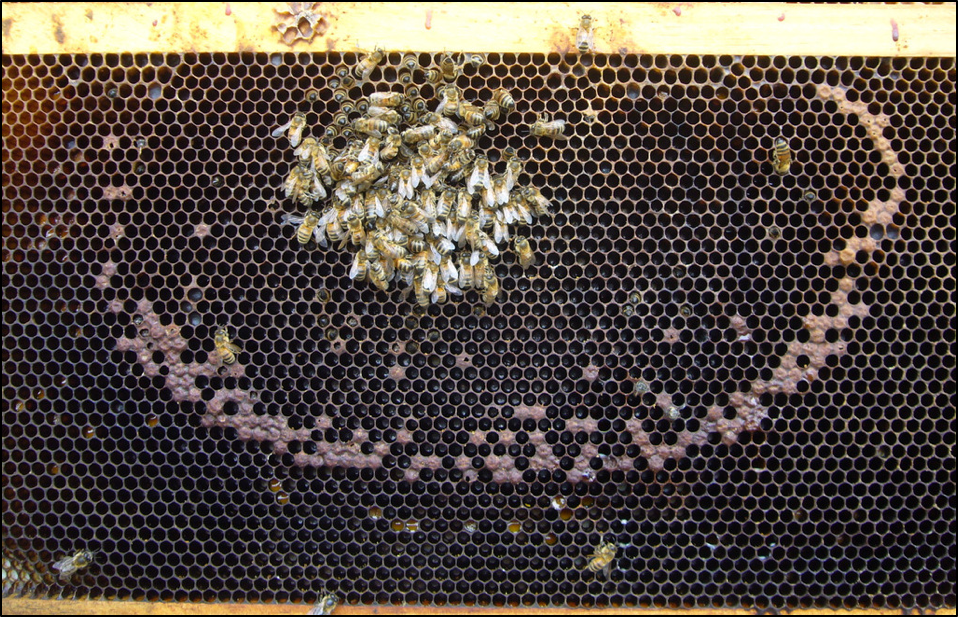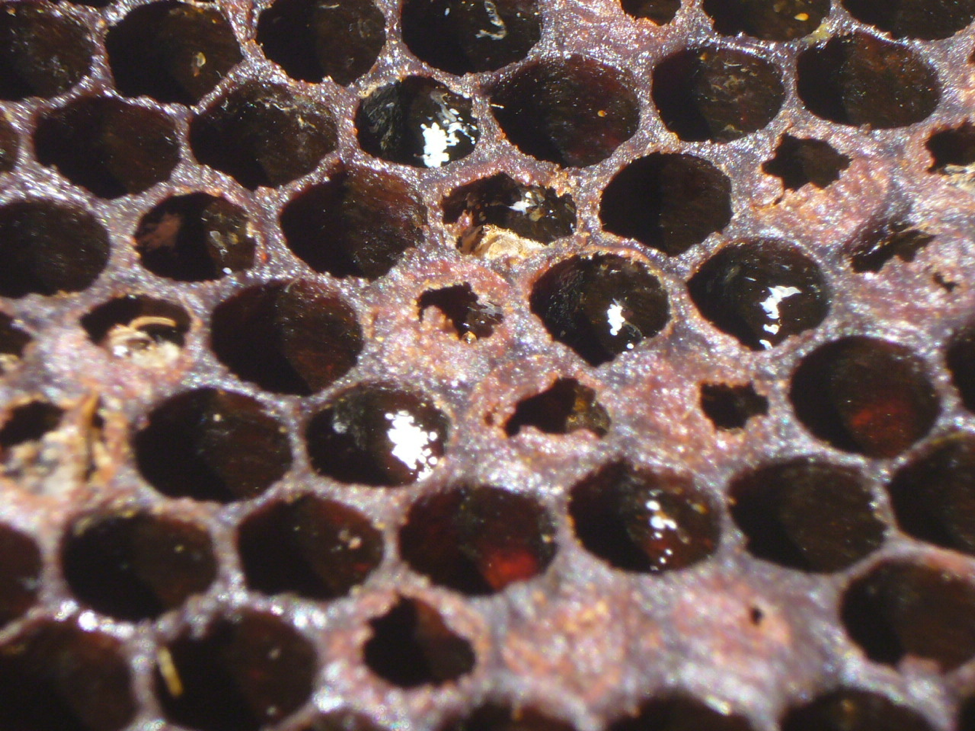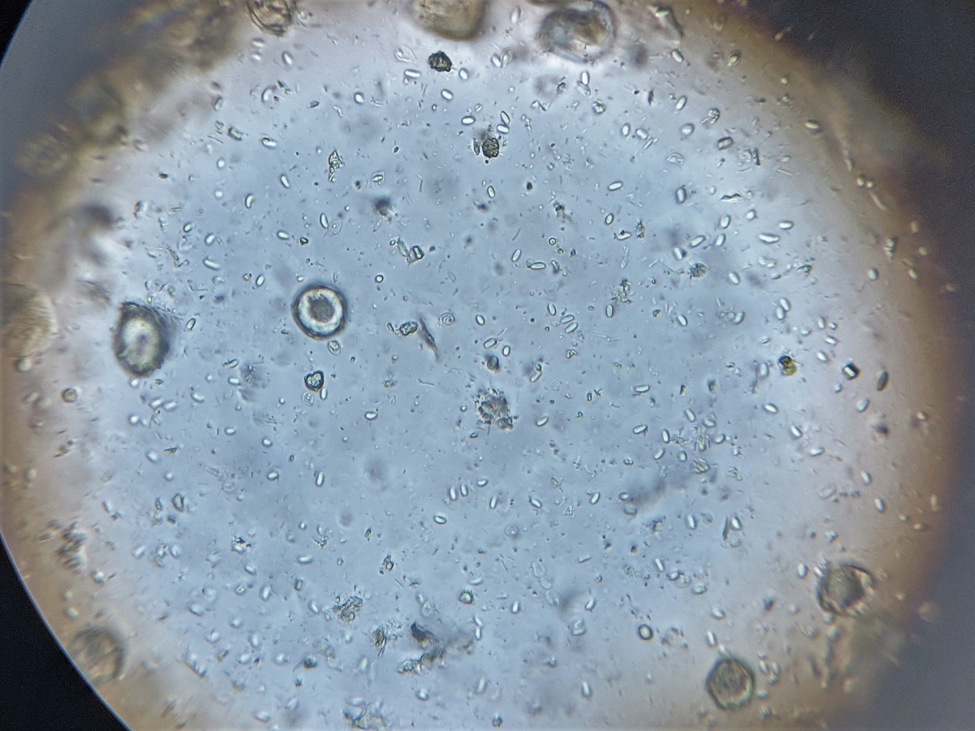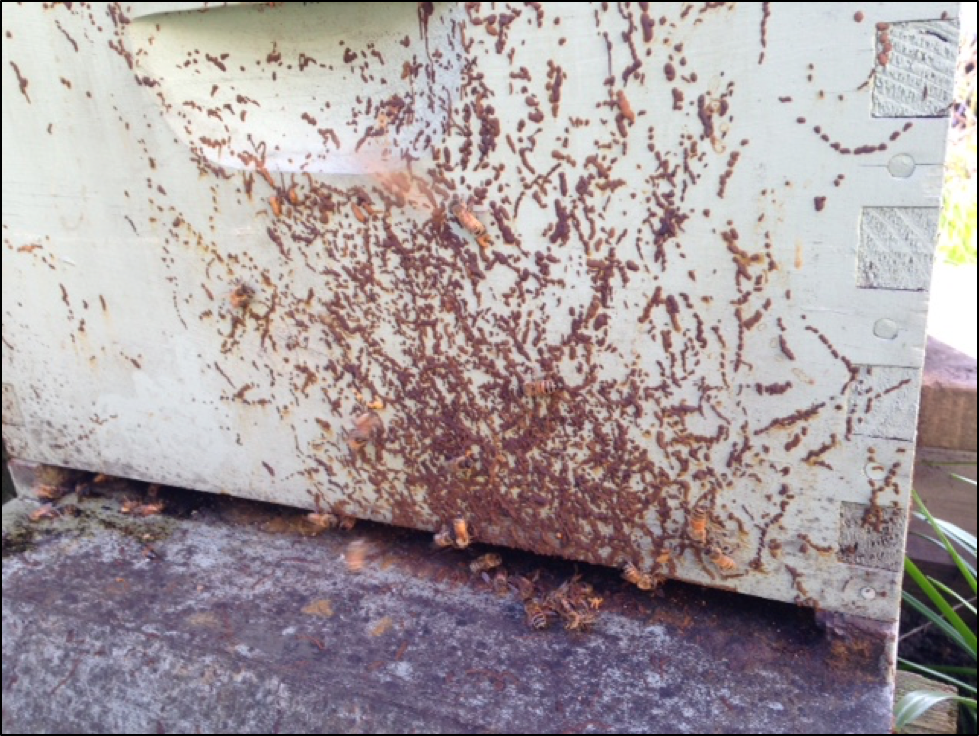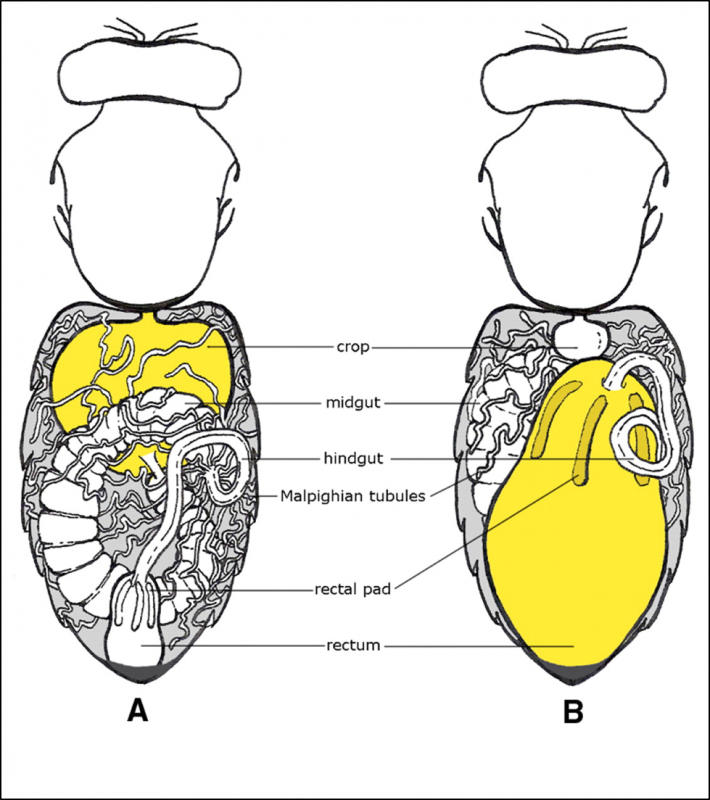The Nosema Problem: Part 1 – It’s “Common Knowledge” that Nosema Causes Dysentery… But is it Actually True?
Contents
So why does everyone think that nosema causes dysentery?. 7
Nosema apparently does not cause dysentery. 7
The Nosema Problem: Part 1
It’s “Common Knowledge” that Nosema Causes Dysentery…
But is it Actually True?
First published in ABJ May 2019
Randy Oliver
ScientificBeekeeping.com
Yesterday I inspected a group of 40 hives returning from almond pollination. All were strong and healthy, other than two unusual deadouts, which no longer had any bees on the combs, and only a scattering of a few dead workers on the bottom boards. One hive had clear signs of dysentery on the top bars; the other didn’t. Upon further inspection, there were small arcs of apparently-healthy sealed brood remaining in both hives, and surprisingly, fresh eggs in the cells below that brood. What could be the cause of these unusual signs?
From my experience, the field signs above point the finger at nosemosis — as described by The World Organisation for Animal Health (OIE) [[1]]:
In a typical case of a colony being depleted because of a Nosema infection, the queen can be observed surrounded by a few bees, confusedly attending to brood that is already sealed.
Exactly as in the photo below, which I took during the CCD epidemic in the early 2000s.
Figure 1. Ten years ago, many beekeepers reported unexplained Colony Collapse Disorder, not associated with varroa. Colonies would quickly dwindle to a “silver dollar sized patch of bees and a queen,” as in this photo. Often times there would be patches of healthy brood remaining after the bees disappeared. I strongly suspect that a large part of the CCD epidemic was a result of the invasive wave of Nosema ceranae, as a part of a “perfect storm” that included evolving viruses, failure of varroacides, and evolving strains of European Foulbrood.
Practical application: Colonies that exhibit healthy brood during cool springtime weather, yet fail to build up, or in which the adult population appears to be declining, may well be suffering from nosemosis.
Nowadays, most of what is now termed “Colony Collapse” is caused by varroa and Deformed Wing Virus (DWV), and can be easily differentiated from collapse due to nosema by the telltale signs of brood dying from the virus, as well as the presence of mite fecal deposits on the ceilings of the cells (Fig. 2).
Figure 2. A typical varroa/DWV deadout, which typically occurs late in the season. Some cells contain dead pupae, or fully-developed adults that were unable to emerge. Note the distinctive traces left by varroa — the white fecal deposits at the top of the cells.
Practical application: Before you blame the collapse of your hive on something else, first pull a central brood frame out of the deadout, and check for the signs above.
But I still occasionally see colonies collapsing from nosema in early springtime. So how about my two deadouts — could nosema have been the cause? And why would only one hive exhibit dysentery? Again from OIE:
In some acute cases [of nosemosis], brown faecal marks are seen on the comb and the front of the hive, with sick or dead bees in the vicinity of the hive. However, the majority of colonies show no obvious signs of infection, even when the disease is sufficient to cause significant losses in honey production and pollination efficiency.
Practical application: So how could I tell whether nosema was the culprit? There’s only one way to tell whether a colony is infected by nosema ― I’ll put it in large type:
The only way for a beekeeper to diagnose nosema infection is by microscopy.
And sure enough, when I crushed dead bee samples from each of the bottom boards, Nosema ceranae spores were clearly evident and in abundance (Fig. 3).
Figure 3. Nosema spores ― the numerous small glowing elongated ovals — from a diluted sample of crushed bees viewed at 400x. The sample from the hive with dysentery looked identical to the one without.
Practical application: Get a microscope, or encourage your local club to purchase one. My favorite for viewing nosema is the Omano 36 [[2]], but even a cheap secondhand ‘scope will do.
So, yes to nosema, but no to having a correlation with dysentery. In fact, I’ve yet to find a single study that has ever demonstrated that nosema ― whether N. apis or N. ceranae — is responsible for causing dysentery.
A request and challenge: If you can find any study that has experimentally confirmed that nosema causes dysentery, please forward it to me.
What is Dysentery?
We’ve all seen it ― dysentery on the front of a hive. Clearly those bees “really had to go” and let loose the moment they took off (Fig. 4).
Figure 4. The telltale signs of dysentery. Even worse is when it’s all over the top bars inside the hive, since it could then quickly spread any gut pathogens or toxic substances throughout the cluster. Photo credit: Monique Vescia
Honey bee workers are remarkably fastidious about hygiene, and do everything possible to avoid defecating within the hive. Foragers wait until they’re on the wing, whereas non-foraging “house bees” take “cleansing flights” when necessary.
Many of us have had to apologize to our neighbors about the orange polka dots on their cars or clotheslines. Although those drops of bee poo are normally a mere annoyance, back during the Viet Nam War, it became an international issue, when accusations were leveled about purported chemical warfare — the evidence being spots of “yellow rain” dotting leaves [[3]]. Such “rain” would have been immediately recognized by any beekeeper who’s enjoyed the experience of walking in an apiary when the sun comes out after the bees had been confined by weather to their hives for several days.
During periods of forced confinement, honey bees have a remarkable ability to “hold it” in order to avoid soiling their nest (for months if necessary). A bee’s rectum has the ability to distend to the point that it nearly fills the abdomen (Fig. 5).
Figure 5. Honey bee abdomen showing a full crop (A) or a full rectum (B). The fully-distended rectum can fill most of the abdomen, and without being relieved by a cleansing flight, can result in the poor bee not being able to “hold it anymore.” The purpose of the rectal pads appears to be for reabsorption of critical mineral ions from the rectal contents. Image © Company of Biologists Ltd., reprinted by permission [[4]]
Practical application: Dysentery is an indication that a colony has a serious problem ― one that sometimes leads to the death of the hive, but not necessarily from nosema. I will later return to the subject of the causes of dysentery.
So Why Does Everyone Think That Nosema Causes Dysentery?
Here’s where we get into one of my pet peeves about honey bee popular books, as well as scientific papers ― people tend to repeat something they’ve heard just because it seems to make sense — but without first actually checking the facts.
I see it in scientific paper after paper. The author says that dysentery is a “sign of nosema” and throws in a citation to support that claim. I’ve checked dozens of those citations, and have yet to find a single one that actually refers to any study that actually demonstrated that nosema infection induced dysentery. Keep in mind that nosema infects the cells that line the bee’s midgut; the “environmental spores” that are found in the hindgut have never been shown to infect or irritate the lining of the rectum. And if nosema did indeed cause lack of hygienic control, you’d expect to see the fecal contents leaking out as little dribbles, not in the huge streaks from a rectum able to be kept full to bursting.
Unfortunately, many authors don’t bother to check, and something that someone once said gets repeated over and over again until it becomes “common knowledge.”
Practical application: This is not the only “common knowledge” myth in the bee literature that possibly needs to be debunked ― I’ll be addressing others in the future.
The Sad Part
The really sad thing about this misconception is that researchers and textbook authors have no excuse for repeating such an assumption, since the lack of nosema-induced dysentery was well established by 1922, and the cause of dysentery by 1935. But I’ve rarely seen any of the many recent papers on nosema cite those nicely-aged, but scientifically accurate studies.
Practical application: Not every author or researcher does their homework. I’ve learned over the years to double check the supportive citations in scientific papers myself, a process that often leads me down a string of misinterpretations (and sometimes to different conclusions than reached by the authors) [[5]]. I’m often appalled by the amount of scientific sloppiness allowed to get by the peer reviewers of papers.
Nosema Apparently Does Not Cause Dysentery
I discovered this when I began deep research into N. ceranae in 2006, and found that most everything that we needed to know about nosema had been clearly explained in a forgotten USDA bulletin published in 1919 [[6]]. I love to read these old studies, and am often impressed by the scientific diligence of the government-funded authors — in this case a G.F. White spent 9 years experimenting with Nosema apis in every way. White’s 58-page summary, in my opinion, still stands as perhaps the most informative study on the parasite, and the disease it may cause, yet published in the English language.
Practical application: One thing that I found was that N. ceranae was not all that different from N. apis. Once the invasive wave of N. ceranae passed through North America in the 2000s, the main differences that I now see between the two species is that ceranae may crop up under certain conditions during warm weather, its spores are far less cold tolerant, and its spore counts may be much higher (although they do not cause a whitening of the hindgut, as with N. apis). Both species are common parasites of the midgut in springtime (with ceranae now being far more prevalent than apis), generally appear to be rather harmless; but may cause disease in stressed colonies.
Allow me to quote Dr. White:
“Care should be observed that Nosema-disease is not confused with dysentery…In fact the two disorders are very different and should be considered, for the present at least, as having no direct relation to each other. As both conditions are widely distributed and occur most frequently in the spring of the year. It is to be expected that not infrequently both of them may be encountered together in the same colony.”
The start of the “association” between nosema and dysentery is perhaps explained by famed bee pathologist Dr. Leslie Bailey [[7]]:
Infection by Nosema apis is commonly believed to make honeybees (Apis mellifera) void faeces in and on the colony instead of away in flight — a condition known as ‘dysentery’ by beekeepers. Evidence that seemed to support this was provided by Lotmar (1951), who found more faeces accumulated in caged infected bees than in healthy ones. No field experiments have shown this effect…
Dysentery was not caused primarily by N. apis, because it occurred whether colonies were severely infected or not…Most of the colonies that survived managed to clear the faeces away; the few still with combs contaminated with faeces were among those with more than 25% of bees infected… If infection is spread by dysentery, this is not unexpected, since infection would spread most in colonies that suffered most dysentery; but if infection causes dysentery a more striking correlation between dysentery and severe infection would be expected than actually occurred.
Practical application: Let me make clear that should a bee already infected with nosema happen to defecate within the hive due to some other gut issue, it will certainly transmit nosema spores to the other bees that clean up the mess. But the dysentery was apparently the result of something other than nosema itself.
Part of the apparent confusion between nosema and dysentery may be due to the fact that they both commonly occur in early spring. In my own apiaries, dysentery comes and goes in the springtime, but after checking numerous dysentery samples (from my own apiaries and numerous samples from others) under the microscope, I have yet to notice any correlation between nosema and dysentery.
Biological evaluation: One could reasonably expect a gut parasite to induce dysentery in its host, as a means of transmission of its spores. But if nosema did indeed induce dysentery, every infected colony would quickly be overwhelmed by spore transmission, and die before spring. This we do not see. Could it be that both species of nosema are actually rather benign parasites, which under “normal” circumstances do not cause appreciable harm to the colony? That is, unless the colony suffers from dysentery due to some other reason.
In France, the impact upon colonies from N. ceranae has been referred to as “dry nosemosis,” since it is clear that the parasite doesn’t cause dysentery. Perhaps we should now question whether N. apis ever did either.
next
In my next two articles I’ll discuss our current state of knowledge about Nosema ceranae ― its seasonality (and the causes for that seasonality), its effects upon colony performance (or lack thereof), and the best ways to monitor for it.
And then I’ll follow with an article about the potential causes of dysentery in bees.
Citations and Notes
[1] OIE Terrestrial Manual 2008. CHAPTER 2.2.4. Nosemosis of Honey Bees http://www.nationalbeeunit.com/downloadDocument.cfm?id=228
[2] https://www.microscope.com/omano-om36-lbk-beekeeper-special.html
[3] Seeley, TD, et al (1985) Yellow Rain. Scientific American 235(3): 128-137.
[4] Image from Nicolson, SW (2009) Water homeostasis in bees, with the emphasis on sociality, © Company Of Biologists Ltd., reprinted by permission.
[5] For instance, it bothered me that an often-cited paper on almond pollination had been misinterpreted by someone who once read it, and then the misinterpretation was then repeated again and again for nearly 50 years by “experts” advising the almond industry; see https://scientificbeekeeping.com/determining-the-relative-value-of-hives-for-almond-pollination/
[6] White, GF (1919) Nosema disease. U.S. Dept Agric Bulletin 780, 59 pp. Available in Google Books.
[7] Bailey L (1967): Nosema apis and dysentery of the honey bee. J Apicultural Res 6: 121-125.




